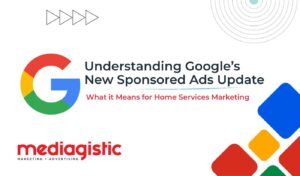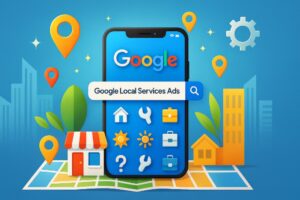
Last Week in Digital Marketing: Google Celebrates Its 20th Anniversary
Think about how many times you use Google each day: to read the news; to search for the nearest gas station; to find answers to your unrelenting questions, such as “Do penguins have knees?” (the answer is yes, you just can’t see them under all those feathers). It’s amazing how big of an impact Google has on our lives, and it’s only 20 years old.
Rather than simply congratulating themselves on a job well done, however, the Google team used their 20th anniversary to discuss what the future has in store — and some of it could have a big impact on your business.
AMP Stories Will Become More Prominent in Search
You may have heard of AMP (Accelerated Mobile Pages) stories, which Google introduced earlier in 2018. These stories are pieced-together videos that appear in search results and display content from web pages in an interesting, interactive video form.
Now, Google is able to extract concepts from images it finds online and then use this content to form AMP stories. For example, one AMP story features information about Michael Jordan from Getty Images, britannica.com, and biography.com. The innovative technological advancement that allows Google to do this is called computer vision, or looking at a photograph and identifying the objects in it based on its pixels, without looking at any of the words on a page.
The Google team hasn’t specified how you can get your content into an AMP story yet. However, information from your website may be used to form an AMP story in the near future (or is currently).
As of now, AMP stories are only available in the Google search app, not in Chrome or Safari. However, Google announced that AMP stories will be more discoverable than before, in both image results and in Google Discover.
Google is also becoming more intuitive when it comes to search: it’s now able to evaluate the question someone types into the search bar, then pull up the most relevant videos to answer that question. For example, if a person typed in “how to make chocolate lava cake,” Google would give that person videos from around the web that show ingredients and supplies used for making chocolate lava cake.
Another part of the Google anniversary update is added details in Image search results. This includes captions that say where an image is published, suggestions for similar search terms, and suggestions for similar images. Some users may have noticed these changes on mobile — now, they’ll be more prevalent on desktop.
One of the most useful updates for online shoppers is the broader application of Lens, an artificial intelligence-powered technology that helps answer questions people have about photos they view online. If someone views an image of a kitchen online and they just need to have the pink polka-dot toaster in the photo, Lens can pick out specific parts of the image and find links to where the objects can be purchased online. So, yes: that adorable toaster is now within reach.
Takeaway: Google knows its users want an interactive experience whenever they’re using any kind of digital media. It’s implementing these features to make it easier for people to gather as much information as possible from one source — Google — in an entertaining manner.
The New “Discover” Feed
In December of 2016, Google released the Feed feature in its app, which had similar characteristics to Facebook’s News Feed: users could see what’s popular online and browse current events, from news to sports to politics. Now, the Google Feed has been renamed “Discover” and displays topic headers that say what certain articles are about, such as “Fashion” or “Writing.” Each article in the Discover feed has a title and photo, and there’s an option to check out recommended sites cultivated specifically for each person, based on which articles they’ve read in the past and what they’ve typed into the search bar.
Although Discover is currently only available in the Google app, it will soon be implemented on the Google homepage on all mobile browsers.
Takeaway: Google is using more organization tactics to make its content more user-friendly and easy to browse.
Activity Cards and Collections Help Users Retrace Their Steps
For those of us who tend to get distracted easily while reading articles, Google has come to our rescue. Activity Cards is a new feature that shows people which sites they’ve looked at in the past when they type a topic into the search bar.
Let’s say I want to learn more about hurricanes. I may look at several websites that explain how hurricanes form, how they travel across oceans, and what dangers they present to coastal communities. Tomorrow, if I type “hurricane categories” into the search bar, Google will pull up my activity related to hurricanes, which includes websites I’ve visited previously. This way, I can go back to a website I found useful, even if I don’t remember the name of it.
With the Collections feature, I can add a web page about hurricanes from my Activity Cards to a collection of other content about hurricanes. This lets me keep all my information about hurricanes together in one space.
Takeaway: Google is taking a hint from Pinterest by creating the Collections feature, which will hopefully draw in users to see Google as more than just a search engine and more as an all-encompassing website moderator.
Minor (Or Not So Minor) Algorithm Update
On September 27th, Google implemented what Danny Sullivan, Google’s public search liaison, called “a smaller” algorithm update. It didn’t impact as many websites as previous updates have, but several site owners are noticing the change, and some in larger ways than others:
While certain sites are experiencing a 30% drop in traffic, others are receiving more traffic than ever. There doesn’t seem to be a common theme in the topic or types of sites that have been affected.
Takeaway: Many of the sites that reported a drastic decline in traffic after the August 1st algorithm update have been gaining their traffic back again to pre-August 1st levels.
Artificial Intelligence Matching Method Improves Search Queries
As another way to show just how advanced its technology has become, Google started using neural matching to better understand synonyms, or words similar to those users type in the search bar. An example of neural matching would be if someone typed in “capital of Greece” and Google gave the search results for “Athens.”
In the official announcement from Google, written by Ben Gomes, the Vice President of Search, Gomes says:
“But we’ve now reached the point where neural networks can help us take a major leap forward from understanding words to understanding concepts. Neural embeddings, an approach developed in the field of neural networks, allow us to transform words to fuzzier representations of the underlying concepts, and then match the concepts in the query with the concepts in the document. We call this technique neural matching. This can enable us to address queries like: ‘why does my TV look strange?’ to surface the most relevant results for that question, even if the exact words aren’t contained in the page. (By the way, it turns out the reason is called the soap opera effect).”
Currently, this neural matching is affecting about 30% of queries, according to Danny Sullivan, Google’s public search liaison.
Takeaway: Google is focusing more on delivering content based on a user’s intent, not on keywords or authority.
All of these changes will undoubtedly impact the way people use Google Search and experience Google overall. If you want your business to stay on top of the SEO game and receive higher levels of traffic, contact the LeadBuilder team. We’ll enhance your online presence with social media, content, and search engine optimization so you get the leads you’re looking for.
 Liz MacLean is an Inbound Marketing Specialist with experience managing social media and creating content for small businesses and nonprofit organizations. She is an award-winning writer who has produced photographs and articles about cooking, clothing, nature, and fitness for local magazines and newspapers.
Liz MacLean is an Inbound Marketing Specialist with experience managing social media and creating content for small businesses and nonprofit organizations. She is an award-winning writer who has produced photographs and articles about cooking, clothing, nature, and fitness for local magazines and newspapers.
Image via iStock
You May Also Like

Understanding Google’s Sponsored Results Update: What it Means for Home Services Marketing
October 20, 2025Google is once again reshaping how paid ads appear in search results, and this change (called the Google Sponsored Results Update) could… Continue Reading Understanding Google’s Sponsored Results Update: What it Means for Home Services Marketing…

Are OTT Ads Served on TV Superior to CTV Ads on Mobile Devices?
September 23, 2025As streaming continues to dominate the media landscape, advertisers face a critical question: where should their OTT ad dollars go, connected TV… Continue Reading Are OTT Ads Served on TV Superior to CTV Ads on Mobile Devices?…

6 Ways to Boost GLSA Performance: The Latest Insights from Google for Contractors
September 3, 2025Google Local Services Ads (GLSA) can be one of the fastest and most effective ways for home services contractors to get qualified… Continue Reading 6 Ways to Boost GLSA Performance: The Latest Insights from Google for Contractors…